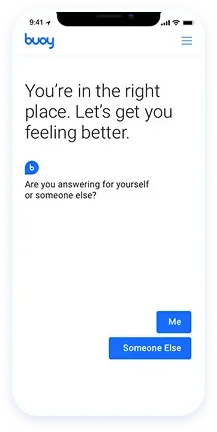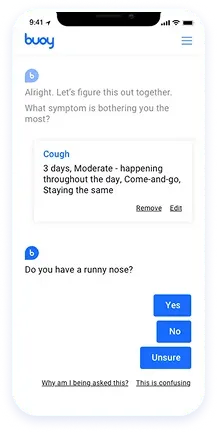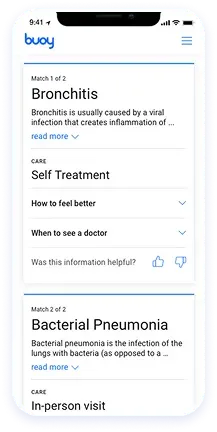Services
SERVICES
SOLUTIONS
TECHNOLOGIES
Industries
Insights
TRENDING TOPICS
INDUSTRY-RELATED TOPICS
OUR EXPERTS

August 28, 2025
AI-based chatbots have been around for years and have already gone through several evolutionary stages, but their popularity has increased with the incorporation of generative AI. This leap forward has helped create chatbots that can mimic the behavior of real users: they understand questions, ask for clarification, and provide a response indistinguishable from a human. Therefore, their operational scope has expanded to include multiple use cases.
Automating appointment management via AI-powered chatbots is a common way to reduce the administrative burden on medical staff. These conversational AI solutions can:
AI-powered chatbots can assist with symptom checking and triage to minimize clerical workloads and quickly direct patients to timely, appropriate care. This includes:
Healthcare professionals can leverage AI chatbots to quickly analyze patient history data regardless of its volume and structure, gaining a comprehensive view of past patient interactions and their medical history to facilitate clinical decision-making.
With their advanced analytics and context awareness capabilities, AI chatbots can provide patients with relevant information anytime and anywhere, helping users play an active role in their personal health care. This involves:
Healthcare chatbots can help ensure patient adherence to treatment plans, especially in the case of complex medication regimes, to achieve better health outcomes. Their tasks can include:
Medical insurance firms can deploy AI chatbots to automate and streamline claims management workflows, ensuring quicker case resolution:
| The global healthcare chatbot market was valued at $1,202.1 million in 2024 and is projected to grow at a CAGR of 24% from 2025 to 2030 | |
|---|---|
| The software segment, which includes revenue from chatbot design and development, dominated the healthcare chatbot market with a share of 64% in 2024 | |
| Chatbot adoption in healthcare is expected to grow by 33.72% between 2024 and 2028, with AI technology fueling this positive trend and paving the way for better patient experiences |
| Symptom checking was the top application in the healthcare chatbot market with a share of 39% in 2024 | |
|---|---|
| 81% of consumers have used a chatbot or AI-powered voice assistant to get healthcare support in the past year. 41% of them said they had a positive experience, compared to just 15% who rated it negatively | |
| 67% of US patients surveyed would feel more comfortable making appointments for sensitive health issues with an AI chatbot than a human operator. In this regard, 48% of patients appreciate AI chatbots because they don't judge, while 38% emphasize that chatbots don't rush them | |
| The most popular use cases for large language models in healthcare include patient question answering (21%), medical chatbots (20%), and information extraction/data abstraction (19%) |
Scheme title: Top prescription refill options according to consumers
Data source: Hyro
A US-based clinic providing psychological consultations partnered with Itransition to develop an AI copilot for patient record keeping and information retrieval. The virtual assistant collects patient data from audio recordings of visits, saves it in the respective EHRs, and shares it with doctors on demand. Additionally, this digital health solution can answer complex questions about previous visits and cases, such as how often and when the patient reported a particular symptom. Three months after the implementation, the clinic reported a 60% reduction in time spent by doctors on administrative tasks, and 92% of specialists noted a reduction in visit preparation time.
Ada is an AI-powered chatbot for symptom checking with over 14 million users and an in-house team of 50 medical experts overseeing its operation. Users can download Ada’s iOS and Android apps to interact with the chatbot and explore a large library of medical conditions on their own. Patients can also create multiple profiles to get different symptom checks for themselves and their family, and monitor health changes over time with Ada’s symptom tracker feature.
Sensely is a conversational AI platform that enables healthcare service providers to build chatbot solutions for appointment booking, triage, chronic condition monitoring, or other medical tasks and integrate them into apps, websites, and messaging solutions. The chatbots are fully configurable through a conversation builder toolkit and feature context awareness to provide personalized assistance based on patient needs and preferences. This includes interacting with users in one of 30 available languages and via their favorite communication channel.

Dot is a healthcare-oriented SaaS platform by Healthily comprising different software products, including an AI-based symptom checker to address health concerns and provide medical information for effective self-care. The chatbot analyzes user-reported symptoms and asks questions to narrow down potential illnesses or conditions to create personalized reports with possible causes and recommendations. Healthcare providers can easily customize and incorporate the artificial intelligence solution into their apps or websites via the platform’s low-code tools.

Buoy is an AI-powered chatbot helping patients interpret their symptoms and choose a potential course of action. After a series of questions to understand the user's condition, whether it's a rash or a fever, the solution provides feedback on possible causes and recommends suitable care options, including self-medication or consulting a doctor. Upon user permission, Buoy can also engage patients with regular follow-ups to monitor their progress.



Image title: Buoy’s user interface
Image source: Buoy
thanks to AI chatbots’ round-the-clock operation and nearly instant response
through fully automated proactive communications, reminders, and updates
based on the analysis of patient data to provide relevant medical information and suggestions
due to the non-human nature of chatbots
due to the greater reach and accessibility of a digital health solution compared to in-person visits
achieved through the automation of time-consuming administrative tasks such as appointment scheduling or prescription refilling
since a single AI chatbot solution can easily serve multiple patients simultaneously
due to chatbots’ extreme accuracy when handling clerical processes like health data entry into EHRs
Concerns | Recommendations | |
|---|---|---|
Inaccuracies & bias |
Despite AI advancements in terms of algorithm performance and accuracy, chatbots can generate biased,
misleading, or fabricated responses and present them as factual information. This can be extremely risky
in a field like healthcare and raise concerns and hesitation among potential users.
|
|
Data privacy & security issues |
AI technology’s heavy reliance on data, both for training and analysis, can raise concerns among the
public and regulators and attract the attention of cybercriminals targeting sensitive information.
|
|
Itransition offers a full range of IT services to help organizations build powerful AI chatbots and integrate them into their workflows or modernize existing solutions with more advanced capabilities.
We design and develop HIPAA-compliant omnichannel chatbots powered by AI algorithms that combine top performance and robust security functionality with intuitive interfaces, ensuring seamless user experiences and strict regulatory compliance.
From business analysis to project planning and supervision, Itransition’s consultants can guide you through every step of the AI chatbot development process to overcome technical challenges and speed up software delivery.
Our specialists audit your AI chatbot solution, fine-tune it, and timely address emerging issues to ensure its correct operation. We can also perform regular software updates or more extensive enhancements in line with your evolving needs.

Before the advent of large language models, the idea of seeking medical advice from a chatbot would have sounded unrealistic, to say the least. Since then, public perception has changed dramatically and patients now view these tools as more than simple appointment schedulers.
Far from replacing human specialists, AI chatbots can now effectively complement both administrative and medical staff to assist patients faster and better while optimizing costs and resources. To secure similar benefits, consider building a tailored AI chatbot solution with an experienced development partner like Itransition.
Nowadays, AI chatbots are primarily based on natural language processing (NLP) and generative AI, especially large language models such as GPT, Claude, and Gemini that enable the solution to interpret and generate context-aware responses in human language. As for chatbots capable of voice interactions, their tech stack includes speech recognition to convert spoken language into text and text-to-speech technology to transform generated text into natural-sounding speech.
Chatbots for the healthcare industry are typically divided into three categories based on their operational scope:
AI chatbots can be integrated with different type of healthcare systems, services, and digital touchpoints, including:

Service
Itransition delivers reliable, secure, and highly scalable AI agents to streamline complex business processes and assist your audience across all channels.

Insights
Learn how machine learning impacts the healthcare sector and discover its most common real-life applications, algorithms, and adoption challenges and solutions.

Case study
Learn how we delivered a PoC of an OpenAI-based web application that answers medical questions interacting with the Davinci AI model.

Insights
Explore recent statistics on conversational AI’s market trends, solution types, features, and adoption fields, along with insights into payoffs and concerns.

Case study
Learn how Itransition developed a customizable automation platform to help healthcare professionals streamline manual tasks, reduce costs, and save time.

Insights
Learn about the key features of primary care telemedicine software, top platforms, and essential integrations along with the benefits for patients and providers.